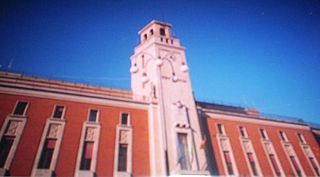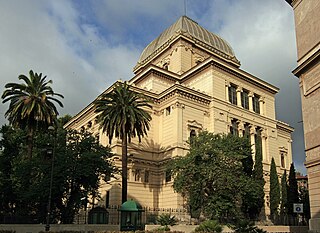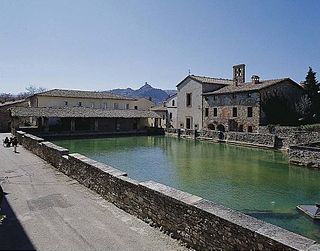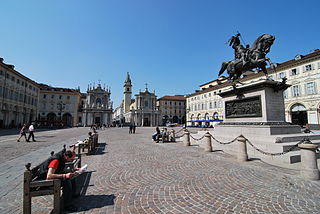| Vallone dei Mulini | |
|---|---|
 | |
| Geology | |
| Age | About 37,000 years old |
| Geography | |
| Location | Sorrento, Italy |
Vallone dei Mulini or Valle dei Mulini (known in English as Valley of the Mills) is a historic valley in Sorrento, Italy.
| Vallone dei Mulini | |
|---|---|
 | |
| Geology | |
| Age | About 37,000 years old |
| Geography | |
| Location | Sorrento, Italy |
Vallone dei Mulini or Valle dei Mulini (known in English as Valley of the Mills) is a historic valley in Sorrento, Italy.
The flour mills, built from stone as far back as the 13th century. Its name derived from its beginning function: to grind grain. The valley originates from the release of waters into a tufa plain about 37,000 years ago, following the eruption of the Campi Flegrei.
A sawmill was providing sawn wood. [1] It was in operation until the beginning of the tenth century. In 1866, Piazza Tasso was established, and it caused the mill and the surrounding sea to be isolated. The building was closed and abandoned in the 1940s.
It is located behind Piazza Tasso. The valley is carved by two rivers: Casarlano-Cesarano and S. Antonino. [2] This also means that the humidity is very high.
It is considered one of the most enchanting views of the Sorrento Peninsula. It is known for its variety and unique plants. These plants settle within ferns. Possible reasons for the appearance of these rare plants include moisture in the area, nearly complete lack of ventilation, sun exposure, and the presence of tuff. [3]



Sorrento is a town overlooking the Bay of Naples in Southern Italy. A popular tourist destination, Sorrento is located on the Sorrentine Peninsula at the south-eastern terminus of the Circumvesuviana rail line, within easy access from Naples and Pompei. The town is widely known for its small ceramics, lacework and marquetry (woodwork) shops.

Enna is a province in the autonomous island region of Sicily in Italy.

Piazza del Duomo is the main piazza of Milan, Italy. It is named after, and dominated by, Milan Cathedral. The piazza marks the center of the city, both in a geographic sense and because of its importance from an artistic, cultural, and social point of view. Rectangular in shape, with an overall area of 17,000 m2, the piazza includes some of the most important buildings of Milan, as well some of the most prestigious commercial activities, and it is by far the foremost tourist attraction of the city.

Campagna is a small town and comune of the province of Salerno, in the Campania region of Southern Italy. Its population is 17,148. Its old Latin name was Civitas Campaniae. Campagna is located in one of the valleys of the Picentini Mountains, at an altitude of 270 meters above sea level.

Sant'Angelo is the 11th rione of Rome, Italy, located in Municipio I. Often written as rione XI - Sant'Angelo, it has a coat of arms with an angel on a red background, holding a palm branch in its left hand. In another version, the angel holds a sword in its right hand and a scale in its left.

Borgo is the 14th rione of Rome, Italy. It is identified by the initials R. XIV and is included within Municipio I.
Chatata, meaning "clear water", is the original Cherokee name of an area located in Bradley County, Tennessee. Today the name survives in references to a number of locations in Bradley County, most notably Chatata Valley in the northeastern part of the county. Chatata was also the original name of an unincorporated community in this region now known as Tasso.

Stio is a town and comune in the province of Salerno in the Campania region of south-western Italy. As of 2016, its population was 872.

Monghidoro is a comune (municipality) in the Metropolitan City of Bologna in the Italian region of Emilia-Romagna, located about 41 kilometres (25 mi) south of Bologna.

The Olona is an Italian river belonging to the Po Basin, 71 kilometres (44 mi) long, that runs through the Province of Varese and Metropolitan City of Milan whose course is developed entirely in Lombardy.

The Central Funicular, is one of four funiculars in the public transportion system of Naples, Italy. The system is a true funicular: an inclined railway with two passenger cars, connected via cables, operating in concert.

Bagno Vignoni is an Italian village and hamlet (frazione) of San Quirico d'Orcia, situated on a hill above the Val d'Orcia in Tuscany. It is a popular tourist destination and well known for its hot springs.

The Cathedral of Saints Philip and James, commonly known as the Sorrento Cathedral, is a Roman Catholic cathedral located on Via Santa Maria della Pietà in Sorrento, Italy. The cathedral is dedicated to Saints Philip the Apostle and James the Just, and has been the seat of the Archbishop of Sorrento-Castellammare di Stabia since 1986. It was previously the seat of the bishops and archbishops of Sorrento.

Piazza Tasso is a central place and square in Sorrento in the south of Italy. The square is named after the poet Torquato Tasso (1544–1595).

Museum Correale is a museum in Sorrento in the south of Italy.

Piazza San Carlo, previously known as Piazza Reale, Piazza d'Armi, and Place Napoléon, is one of the main city squares in Turin, Italy. It was laid out in the 16th and 17th century and is an example of Baroque style.

The ex Jesuits' College is a building in the town centre of Alcamo.

Borgo Vecchio, also named in the Middle Ages Via Sancta, Carriera Sancta or Carriera Martyrum, was a road in the city of Rome, Italy, important for historical and architectural reasons. The road was destroyed together with the adjacent quartier in 1936–37 due to the construction of Via della Conciliazione.

The Sorrento Funicular was a steam-driven, inclined rail system located in the commune of Sorrento, within the Municipality of Naples, Italy — connecting its upper terminus at Sorrento's Hotel Vittoria to the resort's port, several hundred feet below on the Gulf of Naples. The system was designed by Italian engineer Alessandro Ferretti, began operating in 1883 and stopped operating approximately three years later.
Coordinates: 40°37′30″N14°22′35″E / 40.6251°N 14.3763°E